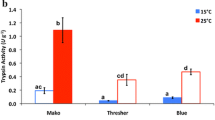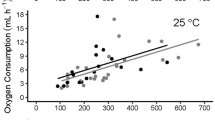Abstract
Temperature sensitivity of digestive processes has important ramifications for digestive performance in ectothermic vertebrates. We conducted a comparative analysis of temperature effects on digestive processes [gut passage times (GPTs) and apparent digestive efficiencies (ADEs)] in five lacertid lizards occurring in insular (Podarcis erhardii, P. gaigeae), and mainland (P. muralis, P. peloponnesiaca, Lacerta graeca) Mediterranean environments. GPTs were negatively correlated to temperature with mainland taxa having 10–20% longer GPTs than island taxa. In contrast to previous studies that estimate ADEs using bomb calorimetry, we compare ADEs by analyzing discrete efficiencies for lipids, sugars and proteins at three temperature regimes (20, 25, and 30°C); each of these categories produces different results. ADEs for lipids and sugars showed a monotonic increase with temperature whereas ADEs for proteins decreased with temperature. Island taxa had consistently higher ADEs than their mainland counterparts for lipids and for proteins but not for sugars. They are characterized by superior energy acquisition abilities despite significantly shorter GPTs. Their increased digestive performance relative to the mainland species appears to allow them to maximize energy acquisition in unproductive island environments where food availability is spatially and seasonally clustered.




Similar content being viewed by others
References
Adamopoulou C, Pafilis P, Valakos ED (1999) Diet composition of Podarcis milensis, P. gaigeae and P. erhardii (Sauria: Lacertidae) during summer. Bonn Zool Beitr 48:275–282
Alexis MN, Papaparaskeva-Papoutsoglou E (1986) Aminotransferase activity in the liver and white muscle of Mugil capito fed diets containing different levels of protein and carbohydrate. Comp Biochem Physiol B 83:245–249
Andrews RM, Asato T. (1977) Energy and utilization of a tropical lizard. Comp Biochem Physiol 58A:57–62
Avery RA (1971) Estimates of food consumption by the lizard, Lacerta vivipara Jaquin. J Anim Ecol 40: 351–365
Barton NWH, Houston DC (1993) A comparison of digestive efficiency in birds of prey. Ibis 135:363–371
Barton NWH, Houston DC (1994) Morphological adaptation of the digestive tract in relation to feeding ecology of raptors. J Zool 232:133–150
Beaupre SJ, Dunham AE, Overall KL (1993) The effects of consumption rate and temperature on apparent digestibility coefficient, urate production, metabolizable energy coefficient and passage time in canyon lizards (Sceleporus merriami) from two populations. Funct Ecol 7:273–280
Bedford GS, Christian KA (2000) Digestive efficiency in some Australian pythons. Copeia 2000(3):829–834
Berne RM, Levy MN (1996) Principles of physiology. Mosby-Year Book Inc, New York
Böhme W (1986) Lacerta graeca (Bedriaga, 1886)—Taygetos-Eidechse, Griechische Spitzkopfeidechse. In: Böhme W (ed) Handbuch der Reptilien und Amphibien Europas, Echsen (Sauria) II. AULA-Verlag, Wiesbaden, pp 255–264
Brashares J, Garland T Jr, Arcese P (2000) The ecology, behavior and phylogeny of the African antelope. Behav Ecol 11:452–463
Bringsoe H (1986) Podarcis peloponnesiaca (Bibron and Bory, 1833)—Peloponnes-Eidechse. In: Böhme W (ed) Handbuch der Reptilien und Amphibien Europas, Echsen (Sauria) II. AULA-Verlag, Wiesbaden, pp 209–230
Carretero MA (1997) Digestive size and diet in Lacertidae: a preliminary analysis. In: Böhme W, Bischoff W, Ziegler T (eds) Herpetologia bonnensis. SHE, Bonn, pp 43–49
Chen XJ, Xu FX, Ji X (2003) Influence of body temperature on food assimilation and locomotor performance in white-striped grass lizards Takydromus wolteri (Lacertidae). J Thermal Biol 28:385–391
Chondropoulos B, Fraguedakis S, Tsekoura N, Tryfonopoulos G, Pafilis P, Valakos ED (2000) Contribution to the study of the genetic variability and taxonomic relationships among five lizard species of the family Lacertidae from Greece. Belg J Zool 130:37–41
Christian KA (1986) Physiological consequences of nighttimes temperature for tropical, herbivorous lizard (Cyclura nubila). Can J Zool 64:836–840
Dearing MD (1993) An alimentary specialization for herbivory in the tropical whiptail lizard Cnemidophorus murinus. J Herpetol 27:111–114
da Diefenbach CO (1975a) Gastric function in Caiman crocodiles (Crocodylia: Reptilia)—I. Rate of gastric digestion and gastric motility as a function of temperature. Comp Biochem Physiol A 51:259–265
da Diefenbach CO (1975b) Gastric function in Caiman crocodiles (Crocodylia: Reptilia)—II. Effects of temperature on pH and proteolysis. Comp Biochem Physiol A 51:267–274
Du WG, Yan SJ, Ji X (2000) Selected body temperature, thermal tolerance and thermal dependence of food assimilation and locomotor performance in adult blue-tailed skinks, Eumeces elegans. J Thermal Biol 25:197–202
Dubois M, Gilles KA, Hamilton JK, Rebers BA, Smith F (1956) Colorimetric method for determination of sugars and related substances. Anal Chem 28:350–356
Garland T Jr, Dickerman AW, Janis CM, Jones JA (1993) Phylogenetic analysis of covariance by computer simulation. Syst Biol 42:265–292
Garland T Jr, Midford PE, Jones JA, Dickerman AW, Diaz-Uriarte R (2002) PDAP: phenotypic diversity analysis programs. Version 6.0. Available at http://www.biology.ucr.edu/people/faculty/Garland/PDAP.html
Gruber U (1986a) Podarcis gaigeae (Werner, 1930)—Skyros-Mauereidechse. In: Böhme W (ed) Handbuch der Reptilien und Amphibien Europas, Echsen (Sauria) II. AULA-Verlag, Wiesbaden, pp 65–70
Gruber U (1986b) Podarcis erhardii (Bedriaga, 1876)—Ägäische Mauereidechse. In: Böhme W (ed) Handbuch der Reptilien und Amphibien Europas, Echsen (Sauria) II. AULA-Verlag, Wiesbaden, pp 25–49
Gruschwitz M, Böhme W (1986) Podarcis muralis (Laurenti, 1768)—Mauereidechse. In: Böhme W (ed) Handbuch der Reptilien und Amphibien Europas, Echsen (Sauria) II. AULA-Verlag, Wiesbaden, pp 155–208
Iverson JB (1980) Colic modifications in iguanid lizards. J Morphol 163:79–93
Harlow JJ, Hillman SS, Hoffman M (1976) The effect of temperature on digestive efficiency in herbivorous lizard Diplosaurus dorsalis. J Comp Physiol 111:1–6
Harris DJ, Arnold EN, Thomas RH (1998) Relationships of lacertid lizards (Reptilia: Lacertidae) estimated from mitochondrial DNA sequences and morphology. Proc R Soc Lond 265:1939–1948
Harwood RH (1979) The effect of temperature on the digestive efficiency of three species of lizards, Cnemidophorus tigris, Gerrhonotus multicarinatus, and Sceleporus occidentalis. Comp Biochem Physiol A 63:417–433
Huey RB (1982) Temperature, physiology, and the ecology of reptiles. In: Gans C, Pough FH (eds) Biology of the reptilia, vol 12. Academic, New York, pp 25–91
Hume ID (1989) Optimal digestive strategies in mammalian herbivores. Physiol Zool 62:1145–1163
Hume ID (2005) Concepts of digestive efficiency. In: Starck JM, Wang T (eds) Physiological and ecological adaptations to feeding in vertebrates. Science Publishers, Enfield, pp 43–58
Hungate RE (1966) The rumen and its microbes. Academic, New York
Ji X, Zhou WH, He GB, Gu HQ (1993) Food intake assimilation efficiency and growth of juvenile lizards, Takydromus septentrionalis. Comp Biochem Physiol 105A:283–285
Ji X, Du WG, Sun PY (1996) Body temperature, thermal tolerance and influence of temperature on sprint speed and food assimilation in adult grass lizards, Takydromus septentrionalis. J Therm Biol 21:155–161
Johnson RN, Lillywhite HB (1979) Digestive efficiency of the omnivorous lizard Klauberina riversiana. Copeia 1979:431–437
Karasov WH, Diamond JM (1985) Digestive adaptations for fueling the cost of endothermy. Science 228:202–204
Layne E (1957) Spectrophotometric and turbidimetric methods for measuring proteins. Methods Enzymol 10:447–455
Maragou P, Valakos ED, Giannopoulos Z, Stavropoulou A, Chondropoulos B (1996) Spring aspect of feeding ecology in Podarcis peloponnesiaca (Bibron & Bory, 1833). Herpetozoa 9:105–110
Maragou P, Valakos ED, Chondropoulos BP (1997) Comparative ecology of two sympatric lizard species, Lacerta graeca and Podarcis peloponnesiaca endemic to Peloponnisos (Greece). In: Böhme W, Bischoff W, Ziegler T (eds) Herpetologia bonnensis. Societas Herpetologica Europea, Bonn, pp 265–271
McConnachie S, Alexander GJ (2004) The effect of temperature on digestive efficiency, gut passage time and appetite in an ambush foraging lizard, Cordylus melanotus melanotus. J Comp Physiol B 174:99–105
McKinon W, Alexander GJ (1999) Is temperature independence of digestive efficiency an experimental artifact in lizards? A test using the common flat lizard (Platysaurus intermedius). Copeia 1999:299–303
Neville A (1975) Biology of arthropod cuticle. Springer, Berlin Heidelberg New York
Pafilis P (2003) Adaptations of lacertids based on their thermal biology, metabolic rate and phylogenetic history. Ph.D. thesis, University of Athens, Greece
Pafilis P, Valakos ED (2004) Temperature effect on the digestive efficiency of the main organic compounds in two Mediterranean lizards. In: Arianoutsou M, Papanastasis I (eds) Proceedings 10th MEDECOS conference, electronic edn. Mill Press, Rotterdam
Perez-Mellado V, Corti C (1993) Dietary adaptations and herbivory in lacertid lizards of the genus Podarcis from western Mediterranean islands (Reptilia: Sauria). Bonner Zool Beitr 44:193–220
Poulakakis N, Lymberakis P, Antoniou A, Chalkia D, Zouros E, Mylonas M, Valakos ED (2003) Molecular phylogeny and biogeography of the wall-lizard Podarcis erhardii (Squamata: Lacertidae). Mol Phylogen Evol 28:38–46
Poulakakis N, Lymberakis P, Valakos E, Pafilis P, Zouros E, Mylonas M (2005) Phylogeography of Balkan wall lizard (Podarcis taurica) and its relatives inferred from mitochondrial DNA sequences. Mol Ecol 14:2433–2443
Ruppert RM (1980) Comparative assimilation efficiencies of two lizards. Comp Biochem Physiol A 67:491–496
Scoczylas R (1978) Physiology of the digestive tract. In: Gans C, Pough FH (eds) Biology of the reptilia, vol 8. Academic, New York, pp 589–717
Simandle ET, Espinoza RE, Nussear KE, Tracy CR (2001) Lizards, lipids, and dietary links to animal function. Physiol Biochem Zool 74:625–640
SPSS Inc. (1989–2002) SPSS 11.0 Mac OS X Version. Chicago, Illinois
Starck JM, Beese K (2001) Structural flexibility of the intestine of Burmese python in response to feeding. J Exp Biol 204:325–335
Starck JM, Beese K (2002) Structural flexibility of the small intestine and liver of garter snakes in response to feeding. J Exp Biol 205:1377–1388
Stevenson RD, Peterson CR, Tsuji JS (1985) The thermal dependence of locomotion, tongue flicking, digestion, and oxygen consumption in the wandering garter snake. Physiol Zool 58:46–57
Taddei A (1951) Contributo allo studio del canale alimentare in Lacerta. Boll Zool 18:291–294
Toledo LF, Abe AS, Andrade DV (2002) Temperature and meal size effects on the postprandial metabolism and energetics in a boid snake. Physiol Biochem Zool 76:240–246
Troyer K (1987) Small differences in daytime body temperature affect digestion of natural food in a herbivorous lizard (Iguana iguana). Comp Biochem Physiol A 87(3):623–626
Valakos ED, Adamopoulou C, Maragou P, Mylonas M (1997) The food of Podarcis milensis and Podarcis erhardii in the insular ecosystems of the Aegean. In: Böhme W, Bischoff W, Ziegler T (eds) Herpetologia bonnensis. Societas Herpetologica Europea, Bonn, pp 373–381
Van Damme R, Bauwens D, Verheyen RF (1991) The thermal dependence of feeding behavior, food consumption and gut-passage time in the lizard Lacerta vivipara (Jaquin). Funct Ecol 5:507–517
Van Marken Lichtenbelt W (1992) Digestion in an ectothermic herbivore, the green iguana (Iguana iguana): effect of food composition and body temperature. Physiol Zool 65:649–673
Waldschmidt SR, Jones SM, Porter WP (1986) The effect of body temperature and feeding regime on activity, passage time, and digestive coefficient in the lizard Uta stansburiana. Physiol Zool 59:376–383
Wang T, Zaar M, Arvedsen S, Vedel-Smith C, Overgaard J (2003) Effects on the metabolic response to feeding in Python molurus. Comp Biochem Physiol A 133:519–527
Witz WB, Lawrence JM (1993) Nutrient absorption efficiencies of the lizard Cnemidophorus sexlineatus (Sauria: Teiidae). Comp Biochem Physiol A 105:151–155
Zar JH (1984) Biostatistical analysis. Prentice Hall, New Jersey
Zhang YP, Ji X (2004) The thermal dependence of food assimilation and locomotor performance in southern grass lizards, Takydromus sexlineatus (Lacertidae). J Therm Biol 29:45–43
Zimmerman LC, Tracy CR (1989) Interactions between the environment and ectothermy and herbivory in reptiles. Physiol Zool 62:374–409
Acknowledgments
The present study was supported by grants from PYTHAGORAS II project of the Greek Ministry of Education and the European Union. We would also like to acknowledge the support of the program for Modern Greek at the University of Michigan. All experimental procedures are in full compliance with Greek national law (Presidential Degree 67/81) on the scientific use and protection of wildlife. Three anonymous reviewers provided insightful comments that greatly improved this article.
Author information
Authors and Affiliations
Corresponding author
Additional information
Communicated by G. Heldmaier
Rights and permissions
About this article
Cite this article
Pafilis, P., Foufopoulos, J., Poulakakis, N. et al. Digestive performance in five Mediterranean lizard species: effects of temperature and insularity. J Comp Physiol B 177, 49–60 (2007). https://doi.org/10.1007/s00360-006-0108-5
Received:
Revised:
Accepted:
Published:
Issue Date:
DOI: https://doi.org/10.1007/s00360-006-0108-5




